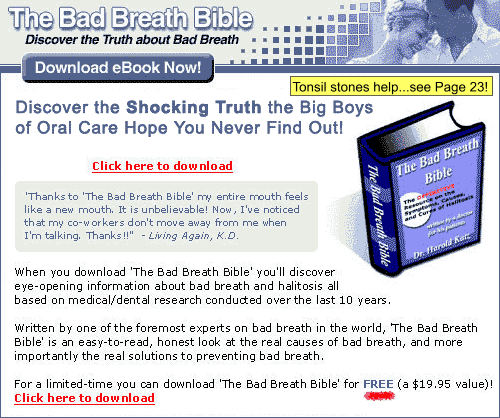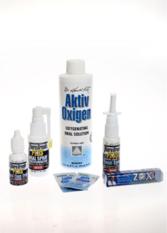
Bad Breath Foods
Foods like onion and garlic are the most common culprits when it comes to situational bad breath. They cause our breath to smell because they contain sulfur compounds similar to those produced by anaerobic bacteria that live in our tongues. The compounds made by bacteria, hydrogen sulfide and methyl mercaptan, smell like rotten eggs or old socks, respectively.
There are four main food categories that stimulate these anaerobic bacteria to produce copious amounts of these volatile sulfur compounds. One of these food groups includes alcohol, a common ingredient in drugstore mouthwashes that can actually make bad breath worse by drying out the oral cavity.
For more about the other foods that promote situational and chronic bad breath, scroll down to read our article, “Foods That May Lead to Bad Breath Due to Volatile Sulfur Compounds”. Don’t let this somewhat imposing title intimidate you. Like all articles written by Dr. Harald Katz, this one takes a down-to-earth approach to bad breath causes and cures.
Foods That May Lead to Bad Breath Due to Volatile Sulfur Compounds
As mentioned previously in this website, the bacteria that create the volatile sulfur compounds of bad breath and taste disorders, react to various changes in their environment.
Of course, everyone knows that onions and garlic will create bad breath. But do you know why? It’s because the odorous molecules in onions and garlic are actually sulfur compounds themselves, called mercaptans. (Sulfur is nature’s way of creating odors.) You’re all familiar with the skunk. Its odor is created as a defense and/or attack mechanism. Skunk odor is made up of sulfur compounds (skatoles, etc.) which are natural sulfur compounds.
Food, if it sits out too long will spoil. That action is due to anaerobic bacteria breaking down proteins in that particular food. In milk, the odor of sour milk is caused by relatives of the bugs that create bad breath, when they break down proteins in milk (and all dairy foods). A reaction takes place where ‘the bad breath bugs’ extract sulfur compounds from the amino acids in these proteins. Specifically, the amino acid cysteine is converted to hydrogen sulfide (the rotten egg smell) and methionine becomes methyl mercaptan (which smells like a cross between old socks and garlic.) The same analogy applies to meat if it sits out too long. There are 4 categories of foods that will result in an increase of sulfur production because these categories have a stimulating affect on the bacteria:
1. Drying Agents
2. Dense Protein Foods
3. Sugars
4. Acids
Drying Agents: The most common drying agent in food is alcohol. Alcohol of course is the basis of all “adult” beverages such as beer, wine, and hard liquor. It is also used, unfortunately in mouthwash, where it only makes the problem worse.
Alcohol is a drying agent, known chemically as a desiccant. It is used quite often in laboratories to “dry out” hard to reach areas in test tubes and beakers. The same end result takes place in the oral cavity.
Although cigarettes are not really food, smoking is probably the quickest way to dry out your mouth, with alcohol the second. If you smoke, you are bound to have bad breath!
Dense Protein Foods: Dairy foods are notorious for creating bad breath. An article in the Los Angeles Times once noted that over 50% of the population in Southern California was “lactose intolerant”**. With regards to bad breath, we have found these people (numbering in the tens of millions) end up with MORE dense proteins available as ‘bad breath fuel’ for the bacteria than those who have no problem with dairy foods (milk, cheese, yogurt, ice cream, etc.) The end result is a buildup of amino acids, which are easily converted into volatile sulfur compounds by the anaerobic bacteria found within the surface of your tongue and throat.
To a lesser extent, we have seen patients who have the same problem with other dense protein foods such as beef, chicken, and fish.
Another problem, thankfully rare, has to do with people who have an inability to break down certain proteins found in beans. This condition is called TMA (trimethylaminuria) and is sometimes known as the “Fish Odor Syndrome”, because the odor produced is similar to decaying fish. The odor consists of sulfur compounds, plus nitrogen compounds (amines). People with this condition must abstain from beans and other dense protein foods.
Sugars: Wouldn’t it be great if we could get rid of bad breath by chewing on M&Ms? Or what if the cure for bad breath were Hershey Kisses?
That’s what the makers of ALTOIDS would have you believe. Altoids, and other products of the same ilk, are trying to fool the public into believing that a strong “good” taste in your mouth is equivalent to the “goodness” of your breath. It is so anti-science, as to be absurd. If you think about it for a minute, it doesn’t even make sense.
By using concentrated MINT flavorings, your taste buds pick up MINT as a a taste. However, ALTOIDS, contains 2 types of sugar, which are fuel for the bacteria to reproduce and create more sulfur compounds. In addition, and here’s the frightening part, other bacteria can take the sugars and produce glycan strands, which in turn end up causing thick layers of plaque on your enamel and around your gums. This leads to tooth decay and gum disease – and of course worse Breath than when you started.
But, since you can’t smell your own breath, you just go merrily along with that great strong mint taste in your mouth, while others close to you are backing away – backing away from your increase bad breath, decayed teeth, and gross swollen, bleeding gums!
Stay away from candies, mints, and chewing gum if they contain sugar.
As an alternative, we have created TheraBreath Oxygenating Chewing Gum. It releases oxygen molecules directly in your mouth and also contains the antibacterial agent, zinc gluconate (found in many cold medications). In addition, as a sweetening agent we chose Xylitol, which is a natural ANTI-DECAY compound (Not SUGAR!) You can order TheraBreath Gum by clicking here:
Acidic Foods: Acidic foods are a problem as you’ll read below. Some foods you should watch out for are:
Coffee – both decaf and regular have acids (Tea is OK)
Tomato Juice
Citrus Juices:
Orange Juice
Pineapple Juice
Grapefruit Juice
pH is a term used to describe the acidity of the environment. (see table) The oral cavity has a normal pH of 6.5 (7 is neutral) which is in the acid range.
We know that acids make the bacteria reproduce much faster. In order to decrease the production of odorous sulfur compounds, we need to neutralize the acid environment. Our products are the only ones to be pH balanced in such a manner to do this most effectively. That is why our products do not leave a strange aftertaste like other products. As one patient recently told me: “I’m so glad I found your products. The taste of (a competitor’s product) was worse than having the problem.
About the author:
Dr. Harold Katz, founder of the California Breath Clinics, is a worldwide expert on the topics of bad breath, halitosis and dry mouth. His Bad Breath Bible is an easy-to-read guide to help YOU experience fresh breath every day for the rest of your life.
**According to the NIH (National Institutes of Health), lactose intolerance is the inability to digest significant amounts of lactose, the predominant sugar of milk. This inability results from a shortage of the enzyme lactase, which breaks down milk sugar into simpler forms that can then be absorbed into the bloodstream. When there is not enough lactase to digest the amount of lactose consumed, the results, although not usually dangerous, may be very distressing. While not all persons deficient in lactase have symptoms, those who do are considered to be lactose intolerant. For most people, though, lactase deficiency is a condition that develops naturally over time. After about the age of 2 years, the body begins to produce less lactase. However, many people may not experience symptoms until they are much older. Between 30 and 50 million Americans are lactose intolerant. Certain ethnic and racial populations are more widely affected than others. As many as 75% of all African Americans and American Indians and 90% of Asian Americans are lactose intolerant. The condition is least common among persons of northern European descent.




